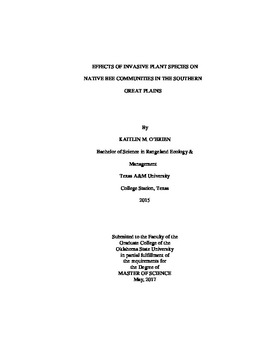| dc.contributor.advisor | Baum, Kristen A. | |
| dc.contributor.author | O'Brien, Kaitlin Mae | |
| dc.date.accessioned | 2018-03-13T18:16:14Z | |
| dc.date.available | 2018-03-13T18:16:14Z | |
| dc.date.issued | 2017-05-01 | |
| dc.identifier.uri | https://hdl.handle.net/11244/54585 | |
| dc.description.abstract | The worldwide decline of native insect pollinators is of growing concern, as well as the decrease in populations of many flowering forbs. In the southern Great Plains region of the United States, grasslands are one of the most important vegetation types for providing resources to pollinators. Non-native and invasive plant species can alter grassland plant communities, although it is not clear how invasive plants affect native bee populations and communities. We evaluated the response of the native plant community and the native bee community across a gradient of invasion levels for two common invasive plants in the southern Great Plains: Kochia scoparia and Salsola tragus. Study sites were located within four National Parks, with approximately 10 plots representing the gradient of invasion levels sampled at each park, for a total of 40 plots. Pan traps were used to assess the native bee community and both native and non-native plant species and cover classes were recorded for each plot. Data were also recorded on bare ground availability due to its importance for solitary ground-nesting bees. Regression models were used to evaluate how the bee community (richness and abundance) responds to invasive plant species cover and bare ground cover, with an analysis performed for K. scoparia and S. tragus combined, since these two species commonly occur together and are expected to have similar impacts on the native bee community. Our findings suggest grasslands with no or low levels of invasive species support higher bee species richness, but did not affect abundance. Plots with higher levels of bare ground showed a significant correlation with bee richness. Possible factors contributing to the observed patterns could be the lack of floral resources from invasive plants (e.g. K. scoparia and S. tragus), which require limited insect pollination, and reduced abundance and diversity of native forbs. This study suggests that invasive plant species control is important for improving grasslands to support diverse native bee communities. | |
| dc.format | application/pdf | |
| dc.language | en_US | |
| dc.rights | Copyright is held by the author who has granted the Oklahoma State University Library the non-exclusive right to share this material in its institutional repository. Contact Digital Library Services at lib-dls@okstate.edu or 405-744-9161 for the permission policy on the use, reproduction or distribution of this material. | |
| dc.title | Effects of Invasive Plant Species on Native Bee Communities in the Southern Great Plains | |
| dc.contributor.committeeMember | Hickman, Karen R. | |
| dc.contributor.committeeMember | Elmore, Dwayne | |
| osu.filename | OBrien_okstate_0664M_15195.pdf | |
| osu.accesstype | Open Access | |
| dc.description.department | Zoology | |
| dc.type.genre | Thesis | |
| dc.type.material | text | |
